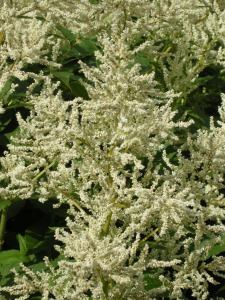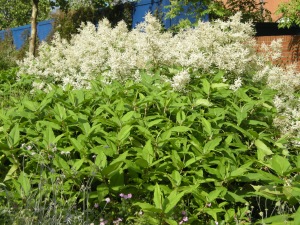Position: Full sun to partial shade
Soil: Moist, well drained
Flowering period: Summer to early autumn
Eventual Height: 2m
Eventual Spread: 3m
Hardiness: 5a, 5b, 6a, 6b, 7a, 7b, 8a, 8b, 9a, 9b
Family: Polygonaceae
Persicaria polymorpha is a deciduous perennial with an upright, clump forming habit. Its foliage is lanceolate, mid to dark green leaves with lateral venation, emanating from a central midrib and are borne on red stems. Its inflorescence is long lasting and takes the form of hermaphroditic, creamy white panicles which will become a reddish-brown in autumn.
Persicaria polymorpha, commonly known as the Great White Fleece Flower or the Giant Fleece Flower, is native to China, Korea and Japan. It is closely related to the highly invasive Japanese Knotweed but is not known as an invasive plant; however some reports claim it has become so in parts of America. The foliage is edible but contains oxalic acid (found in rhubarb, Rheum spp.) which can bind nutrients in the body making them unavailable for uptake in the body.
The etymology of the binomial name Persicaria was a medieval name referring to the likeness of the leaves to a peach tree, Prunus persica. Polymorpha is derived from the Latin meaning ‘Many forms’.
Persicaria polymorpha may be useful to the landscape architect as a low maintenance long flowering large perennial. As it has not been widely grown in the UK not much information is available on how it will deal with our climate, although the specimen shown in this blog is thriving.
Persicaria polymorpha will tolerate almost any soil conditions; it will be happy in acid, neutral or alkaline pH levels, in loam, sand, chalk or clay based soils in a sheltered or exposed location facing any aspect.
Persicaria polymorpha will not have a large positive ecological impact as it is not native to this continent and as such has no established symbiotic relationships or organisms, which prefer it as a habitat.
Persicaria polymorpha requires no maintenance. Dead material may be cut back to the ground in late autumn or winter. This plant may be divided in spring.






I have searched and searched as to how to divide Giant Fleece flower, can you be specific as to how? BTW, I live in zone 2b temps can drop to -40C and lower and my plant has survived without any maintenance, but it’s getting too big and I’d like to get some divisions. Hope you can help. 🙂
It is interesting to hear Persicaria polymorpha is surviving in Zone 2b, where in the world do you live?
I would suggest you divide in spring after the ground has thawed, the soil is dry enough to work and the plant has not started to produce growing shoots. Lift plant with a garden fork (if it is not to large) and divide clump with two garden forks. A spade may be required to divide the clump if the centre has become woody. If the clump is too large to lift in one go I would suggest you loosen the edge of the clump as much as possible with a garden fork. Then remove chunks of plant material from the edge of the clump, separating them using a garden fork if possible, otherwise cutting them off using a spade. You should be able to repeat this process around the clump, moving in towards its centre unless it has become too woody or dead. I hope this helps.